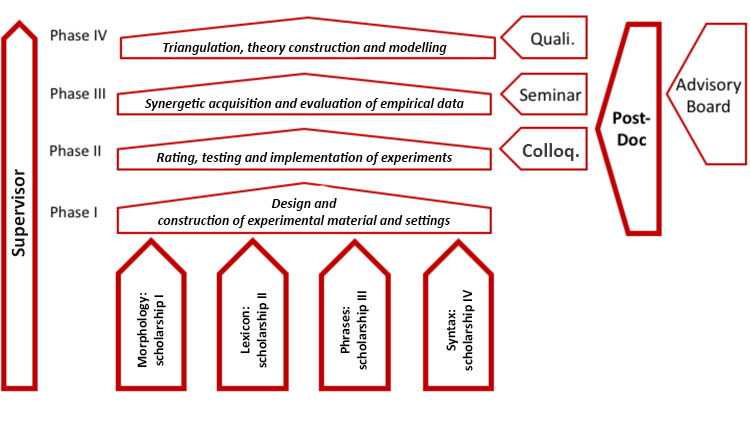“Simply complex! A multimodal and interdisciplinary approach to examine linguistic complexity within Easy Language“
Easy Language was developed through practical experience in Germany. In 2009, two sets of rules and regulations were published: the “European standards on how to make information easy to read and understand”, created by Inclusion Europe, and “The Rules for Easy Language” formulated by the Netzwerk Leichte Sprache. The latter served as a basis for a manual published by the German Federal Ministry of Labour and Social Affairs, which contributed to increased visibility of the rules for Easy Language. However, these first two sets of rules and regulations were merely based on intuition (see Bredel / Maaß 2016a: 67) and are, in many respects, formulated vaguely. However, the manuals can nonetheless be credited for their pioneering work in the German-speaking area. With the foundation of the centre for Easy Language at the University of Hildesheim in 2014 and the publication of “Leichte Sprache. Das Regelbuch” (Maaß 2015), Easy Language was provided with a scientifically-based linguistic foundation for the first time. According to the current state of research, Easy Language is a monomedially written, reduced and regulated variety of the German language, coined by immediacy and asymmetric conditions of usage and acquisition (see Bredel / Maaß 2016a: 58f.).
With respect to theoretical modelling of Easy Language, great progress has been achieved, as evidenced by the publication of the handbook “Leichte Sprache. Theoretische Grundlagen. Orientierung für die Praxis” (Bredel / Maaß 2016a) as well as the more practical manual “Ratgeber Leichte Sprache. Die wichtigsten Regeln und Empfehlungen für die Praxis“ (Bredel / Maaß 2016b).fehlungen für die Praxis“ (Bredel / Maaß 2016b) niederschlägt.
The rules for Easy Language, now with a scientific-linguistic foundation, for the most part still lack empirical investigation. Bock, Lange and Fix (2017: 19) postulate that the empirical investigation of Easy Language is only just getting started in the German-speaking area while Christmann (2017) rightly discusses empirical gaps in a well-meant concept. The empirical investigation of comprehension of Easy Language is currently restricted to the effect of the interpunct.
The research group „Simply complex! A multimodal and interdisciplinary approach to examine linguistic complexity within Easy Language” focuses on the existing research gap: the major objective is the investigation of the empirical validity of the postulated rules for Easy Language, combined with evidence from linguistic complexity research, and the further, evidence-based development of these rules. Therefore, we conduct multimodal studies which also serve to develop a neurobiologically-feasible model of Easy Language. The main differences between the doctoral projects are their respective areas of focus.


Schematischer Arbeitsplan
- Bock, Bettina M. / Lange, Daisy / Fix, Ulla (2017): Das Phänomen „Leichte Sprache“ im Spiegel aktueller Forschung – Tendenzen, Fragestellungen und Herangehensweisen. In: dies. (Hrsg.): „Leichte Sprache“ im Spiegel theoretischer und angewandter Forschung. (Kommunikation – Partizipation – Inklusion 1). Berlin: Frank & Timme, 11–31.
- Bredel, Ursula / Maaß, Christiane (2016a): Leichte Sprache. Theoretische Grundlagen. Orientierung für die Praxis. (Sprache im Blick). Berlin: Dudenverlag.
- Bredel, Ursula / Maaß, Christiane (2016b): Ratgeber Leichte Sprache. Die wichtigsten Regeln und Empfehlungen für die Praxis. (Sprache im Blick). Berlin: Dudenverlag.
- Christmann, Ursula (2017): Wie leicht darf Leichte Sprache sein? Empirische Lücken in einem gut gemeinten Konzept. In: Bock, Bettina M. / Lange, Daisy / Fix, Ulla (Hrsg.): „Leichte Sprache“ im Spiegel theoretischer und angewandter Forschung. (Kommunikation – Partizipation – Inklusion 1). Berlin: Frank & Timme, 35–51.
- Inclusion Europe (2009): Informationen für alle. Europäische Regeln, wie man Informationen leicht lesbar und verständlich macht. Online unter URL: http://easy-to-read.eu/wp-content/uploads/2014/12/DE_Information_for_all.pdf.
- Maaß, Christiane (2015): Leichte Sprache. Das Regelbuch. (Barrierefreie Kommunikation 1). Münster.
- Netzwerk Leichte Sprache (2013): Leichte Sprache. Ein Ratgeber. Herausgegeben vom Bundesministerium für Arbeit und Soziales. Paderborn: Bonifatius GmbH.





